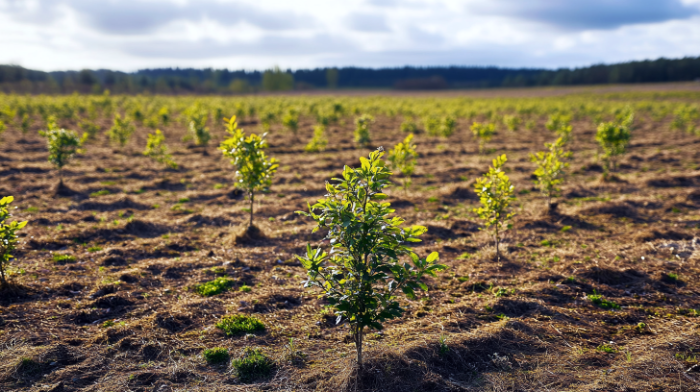Everything You Need to Know About Afforestation
Afforestation is the process of creating forests in areas where trees were absent before. By planting trees on damaged land or unused spaces, we can help fight climate change and restore wildlife.
This isn’t just about adding greenery to the world. Afforestation has many benefits. It helps remove carbon dioxide from the air, prevents soil from washing away, and creates animal habitats. For example, abandoned farmland can be turned into healthy forests that improve air and water quality.
In addition to traditional planting methods, new technologies are helping with afforestation. Hydroponics, for example, is a way to grow plants without soil. It’s used to grow tree seedlings in areas with poor soil or harsh climate. Vertical farming also plays a role by using less space and water while producing trees and crops efficiently.
Afforestation is happening all over the world. Projects in China, India, and Israel turn deserts and empty spaces into green forests. In cities, vertical farms are adding greenery while providing food.
This article will explore everything you need to know about afforestation. We'll discuss its goals, methods, and examples worldwide. You’ll also learn about the challenges involved. Finally, we'll explore how technologies like hydroponics are helping.
Afforestation Goals
Afforestation has many goals that help the environment and communities. These efforts are essential for creating a more sustainable planet.
Reducing Atmospheric CO₂
The main goal of afforestation is to lower the amount of carbon dioxide (CO₂) in the air. Trees absorb CO₂ as they grow, storing it in their roots, trunks, and soil. This process is called carbon sequestration. It's one of the best natural ways to reduce the greenhouse gases that cause global warming. By planting trees on empty or damaged land, we can remove CO₂ from the atmosphere and help slow climate change.
Preventing Soil Erosion and Restoring Biodiversity
Afforestation also helps protect and restore the land. Tree roots hold soil in place, preventing erosion caused by wind and rain. This keeps the soil healthy and full of nutrients. Forests also bring back plants and animals by creating safe habitats, which improves biodiversity. A diverse environment is more stable and better at handling changes in the climate.
Using Modern Technology
Innovative farming methods, like commercial hydroponic systems, support afforestation. These systems grow tree seedlings without soil, using water rich in nutrients. This method works well in places where the land is poor, or the climate is dry. Hydroponic systems also produce healthier trees ready to thrive when planted in new forests.
Greening Cities
Afforestation is not just for rural areas. In cities, vertical farming and hydroponics are being used to add more green spaces. These methods make cities cooler, improve air quality, and lower the carbon footprint of urban areas. Vertical farms can grow plants and trees in small spaces like rooftops or unused lots. This helps create more greenery in crowded places, even where land is limited. Urban forests and vertical gardens can also help. They may provide shade, reduce noise pollution, and improve the mental well-being of people living in these areas.
Types of Afforestation
Afforestation can take many forms, depending on the goals and type of land. Each method helps create forests and improve the environment in its own way.
Natural Regeneration
Natural regeneration allows trees to grow independently from seeds already in the soil or spread by wind and animals. This method works best where the land can support tree growth without much human help. Native trees grow naturally, creating new ecosystems for plants and animals. These forests are also good at absorbing carbon dioxide, making them a strong tool for fighting climate change.
Agroforestry
Agroforestry is a way to plant trees while growing crops like fruits and nuts. It combines farming and forestry to benefit both. Trees in agroforestry systems protect the soil, add nutrients, and provide shade for crops, making farms more resilient to heat and drought. Agroforestry also helps farmers earn money while supporting the environment by planting trees.
Innovative Agroforestry
Innovative agroforestry can make a big difference in areas with limited space. Vertical farming structures can grow trees and crops in small or damaged areas. For example, rooftops or abandoned urban lots can be turned into green spaces. These setups use space wisely and bring greenery to places that need it most.
Tree Plantations
Tree plantations grow forests for products like wood, paper, and fuel. These plantations help reduce the need to cut down natural forests. They can capture carbon and protect ecosystems while meeting economic needs when managed well.
Sustainable Crop Systems
Hydroponic systems in hydroponic greenhouses make growing trees easier in dry areas. Hydroponics grows plants using water with nutrients instead of soil, saving space and resources. This method is fast and uses less water, so it’s great for areas where traditional tree planting is difficult. Healthy seedlings grown in hydroponic greenhouses are then planted to create new forests.
These methods show how afforestation can work in many environments, helping people and the planet.
The Process of Creating a Forest
Creating a forest is a step-by-step process that involves careful planning and preparation. Each stage ensures the new forest can grow and thrive in its environment.
Site Selection
The first and most important step is choosing the right location. To decide if an area is suitable for a forest, experts consider factors like climate, soil quality, existing vegetation, and human activity. For example, areas with poor soil or harsh weather may need extra preparation before trees can grow. By understanding these conditions, planners can select the best sites for afforestation.
Site Preparation
Once a site is chosen, it needs to be prepared for planting. This step can include mechanical methods like chopping and mounding to clear land and create planting areas. In some cases, chemical methods like herbicides are used. These chemicals remove weeds or invasive plants that might compete with tree seedlings. Prescribed burning, a controlled method of clearing vegetation can also help. This method enriches the soil with nutrients. Proper preparation ensures that young trees have the best chance to grow.
Planting Methods
There are several ways to plant trees, depending on the needs of the forest.
Direct Seeding: Seeds are sown directly into the soil, a simple and cost-effective method.
Seedling Planting: Young trees with established roots are planted, giving them a better chance of survival.
Hydroponic Seedling Growth: In this method, seedlings are grown in controlled environments using nutrient-rich water instead of soil. Hydroponics produces healthier, stronger plants that can thrive when transplanted into forests.
Afforestation by Cutting: This involves using tree parts that can sprout new growth. It’s a fast way to establish forests with certain tree species.
Afforestation Around the World
Afforestation efforts are happening worldwide. Many countries are using creative methods to plant trees and restore the environment.
China
China is home to one of the largest afforestation projects in the world, the "Great Green Wall." This project, started in 1978, is planting trees across northern China to stop the spread of the Gobi Desert. The program is expected to last until 2050. It hopes to create extensive forests to protect the land and reduce desertification.
India
India currently has several initiatives aimed at creating more green spaces. Their National Afforestation Program is working to increase forest cover and bring life back to damaged land. Another effort is called the Green India Mission. It focuses on improving ecosystems and planting trees to help with climate change. These programs are vital for restoring India’s natural environment. They will also help capture carbon from the atmosphere.
Israel
In Israel, the Jewish National Fund leads projects that have turned dry, desert areas into thriving forests. The fund uses advanced irrigation and plants trees that need little water. By doing so, these efforts have transformed the land. They show how afforestation can succeed even in harsh climates.
Urban Success Stories
In crowded cities, vertical farming and hydroponics are helping create green spaces. For example, Singapore has built vertical gardens on buildings, improving air quality and making the city greener. In New York, rooftop hydroponic farms grow food while adding greenery to urban areas.
Growing Forests Without Halting Agriculture
Planting forests to fight climate change and restore ecosystems doesn’t mean we have to give up farming. Afforestation sometimes involves converting farmland into forests. At the same time, innovative methods like vertical farming allow forests and agriculture to coexist.
Maximizing Land Use Efficiency
Vertical farming is a way to grow crops using far less land than traditional farming. These farms grow plants in stacked layers, often inside buildings or greenhouses. This approach is especially useful in areas where limited space or farmland is converted into forests. It requires only a small fraction of the land that traditional farms need. This allows vertical farming to help balance the need for food production to expand forests. For more on this, see the differences in vertical farming and traditional farming.
Water Conservation
Traditional farming uses much water and can worsen water scarcity, especially in dry regions. Vertical farming, on the other hand, uses closed-loop systems that recycle water. This method reduces water use by up to 98%, preserving resources for other uses. With less pressure on water supplies, vertical farming supports sustainable food production and afforestation efforts.
Year-Round Productivity
Vertical farms can grow crops year-round, unlike traditional farms that depend on seasons. They use controlled environments with the perfect light, water, and nutrients. Indoor farms grow a continuous supply of food regardless of season or weather. This stability helps meet global food demands without needing extra farmland.
Sustainable Crop Production
Vertical farms use advanced systems like hydroponics, allowing plants to grow more efficiently. These methods eliminate the need for soil and reduce pesticide use. As a result, vertical farming creates high-quality crops while using fewer natural resources.
Integrating Green Spaces and Food Production
By combining vertical farming with afforestation, we can grow food and forests side by side. Farmland can be restored into forests, while vertical farms provide the necessary crops. This balance helps fight climate change, restore ecosystems, and ensure a steady food supply.
Is It Working?
Afforestation is a powerful tool for combatting the effects of agriculture on the environment. Yet, its success depends on careful planning and execution. While it offers many benefits, some challenges need to be addressed to ensure long-term success. Understanding both sides helps us improve how afforestation is practiced worldwide.
Benefits
Afforestation helps fight climate change by capturing CO₂ from the atmosphere through carbon sequestration, reducing greenhouse gases, and slowing global warming. New forests also prevent soil erosion by stabilizing the land with tree roots, keeping the soil healthy and in place. In dry regions, afforestation can stop desertification and protect areas at risk of becoming barren. Additionally, forests support biodiversity by creating habitats for plants and animals. They provide vital ecosystem services, like filtering water, purifying air, and reducing local temperatures.
Challenges
Despite its advantages, afforestation can lead to problems if it isn’t done responsibly. Planting non-native trees might harm local ecosystems by crowding out native species. Large-scale projects also require high costs and resources, making them difficult to maintain. Another challenge is monocultures, where only one type of tree is planted. This can reduce biodiversity and make forests more likely to suffer from pests or diseases.
Partnering with Eden Green for a Greener Tomorrow
Eden Green’s hydroponic systems are changing the way food is grown. These systems help retailers by providing a steady supply of fresh produce delivered within 48 hours of harvest. This means customers get high-quality, flavorful foods with less waste.
Retailers can also customize hydroponic produce to match their brand. Private-label options allow businesses to create products their customers will love. Hydroponics uses much less water and space than traditional farming, making it a smart environmental choice.
By working with Eden Green Technology, businesses can meet customer demands while helping to protect the planet. If you're interested in partnering with us or just want to learn what we can offer your brand, contact us today.
Afforestation FAQs
What Does Afforestation Mean?
Afforestation is the process of planting trees in areas where there were no forests before. It can involve turning empty land, such as abandoned farmland or degraded areas, into thriving forests.
Why Is Afforestation a Good Thing?
Afforestation has many benefits. It helps fight climate change by absorbing carbon dioxide. It also prevents soil erosion and creates habitats for wildlife. Finally, it improves air and water quality and can provide economic opportunities through sustainable forestry.
How Long Does Afforestation Take?
The time depends on the type of trees and the conditions of the land. Some fast-growing species can be established within a decade, while a mature forest with diverse ecosystems may take 20–50 years or more.
How Does Afforestation Help Deforestation?
While deforestation removes trees, afforestation replaces lost forests and expands tree cover. By creating new forests, afforestation helps restore ecosystems damaged by deforestation and offsets carbon emissions.
What Is Afforestation vs Reforestation?
Afforestation involves planting trees in areas that were never forests. Reforestation, on the other hand, restores forests that have been cut down or destroyed. Both play key roles in combating climate change and restoring biodiversity.
Why Is Afforestation Necessary for Us?
Forests are vital for life on Earth. They clean the air, filter water, regulate the climate, and support countless species, including humans. Afforestation helps ensure these benefits continue despite facing deforestation and climate change challenges.










